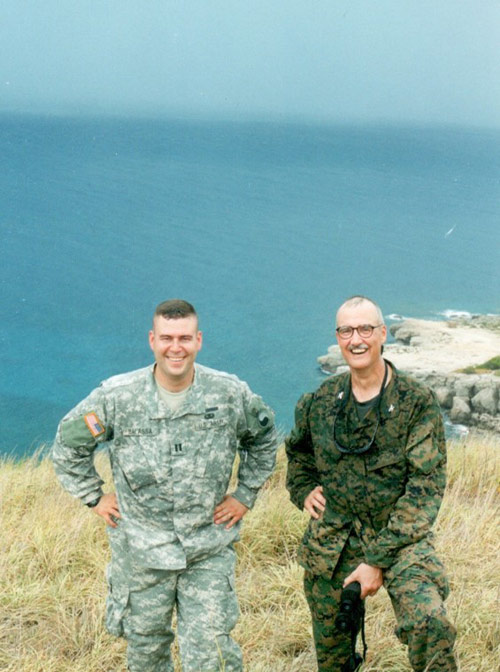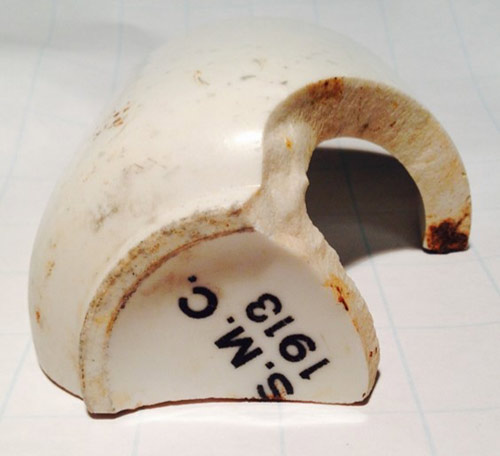
Paul Balassa and Turk McCleskey in Cuba

Fragment of an original 1913 watch mug found on Glass Beach

Turk (far right) working with the Homer Laughlin China Company to replicate the original mug
The Discovery
Like many people stationed at Guantanamo Bay, Turk McCleskey (Colonel, U.S. Marine Corps Reserve) was immediately fascinated by the environment of southern Cuba. It reminded him of arid west Texas. Chaparral and cactus eked out a living from rocks and sand, with one big difference — the zone where the desert meets the Caribbean Sea.
In his off-duty hours, Turk explored those margins, and around the time Paul Balassa (then a captain, U.S. Army Reserve) arrived at Gitmo, one of Turk’s sergeants reported an unusual discovery. While scuba diving off Glass Beach, she found a porcelain sherd inscribed “U.S.M.C.” Turk was familiar with the general area, so he planned to look for more. By chance, he ran into Paul and invited him to explore the site together.
As it turned out, Glass Beach was the central dump for the Naval Base at Guantanamo Bay for decades during the early 20th century. In 1917, the base held the largest rifle range in the western hemisphere. In the late 1920s, the enlisted mess hall that supported the range burned and collapsed, crushing the normally durable heavy porcelain dishes from which Marines ate their meals and drank their coffee. To prepare the site for a replacement mess hall, the charred wreckage was removed and thrown over a cliff. In addition to porcelain sherds, Turk and Paul found many other types of debris there, including glass bottles (which gave Glass Beach its name) and discarded metal objects that left rust stains on many of the porcelain sherds.
When Turk and Paul first started finding dated U.S.M.C. sherds, they hoped to discover an intact piece. No such piece emerged from the dirt. And then, one day on the site, it occurred to Turk — make one.
So Turk and Paul partnered with the Homer Laughlin China Company, a giant in American porcelain production that has operated in Newell, West Virginia, for over 100 years. The 1917 Centennial Watch Mug™ precisely replicates both the shape and the industrial process of the original model produced in 1917. The manufacturing process, known as jiggering, mechanically presses clay into a mold with a curved template. Weighing 1.25 pounds, the heavy result is at once durable, functional, and elegant.
The legendary Marine Corps noncommissioned officers of World War One practiced marksmanship under the Cuban sun at the Guantanamo Bay rifle range. They began each day drinking coffee from the mugs that ended up broken in the Glass Beach dump. If they were here today, a century later, those Marines wouldn’t be able to distinguish this mug from their originals. So go ahead and hold some history.
